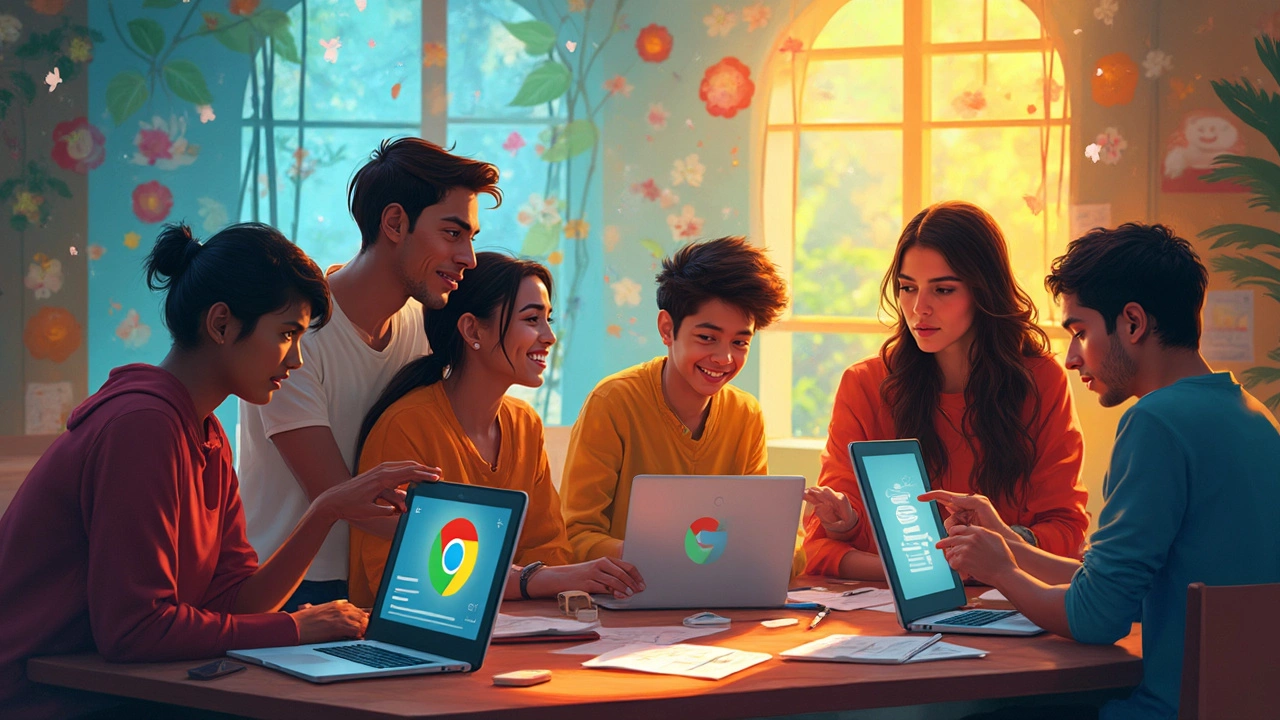Everybody uses Google, but calling it an e-learning platform might be stretching things. Sure, Google shapes how millions pick up new facts, but it’s not built like those platforms where you sign up, track progress, or earn badges. Still, this tech giant is everywhere in online learning. Confused yet? You’re not alone.
If you Google any question, you’ll get answers fast. But what if you need a teacher, lessons, or step-by-step feedback? Google on its own doesn’t package that for you. What it does give is a set of tools that can help you learn just about anything—if you know how to use them together.
Let’s get real: tons of teachers use Google Docs for assignments, YouTube for tutorials, or Google Classroom to post homework. But does that make Google an official e-learning platform, or is it more like a toolbox everyone borrows from?
You don’t need to be a tech wizard to get something out of Google’s tools, but they work best when combined for a purpose. Use Google Drive to organize study notes, fire up Google Meet for group discussions, or check out YouTube playlists made by real educators. Want things more structured? Google Classroom comes in handy, especially for schools. But if you’re looking for full-fledged online courses with certificates, you’ll soon notice the limits.
- Clearing Up the Confusion: Is Google an E-Learning Platform?
- What Google Actually Offers for Learning
- Digging Into Google Classroom
- Google vs. Traditional E-Learning Platforms
- Smart Ways to Use Google Tools in Online Learning
- Where Google Falls Short—and What to Watch Out For
Clearing Up the Confusion: Is Google an E-Learning Platform?
Lots of folks wonder if Google itself is an actual e-learning platform. Here’s the deal—Google is mostly a tech company and a search engine, not a single space built just for online education. When you hear about e-learning platforms, think about places like Coursera, Khan Academy, or Udemy. Those are built for structured courses, grading, quizzes, and completion proof. Google, on the other hand, offers tools you can mix and match for learning, but it’s not an all-in-one learning site.
Why do people get mixed up? Two reasons. First, Google tools like Google Classroom are everywhere in schools. Second, a massive number of teachers and students use Google Docs, Slides, and YouTube in class. But these are just tools—they don’t add up to a full course platform unless a teacher organizes them that way.
Check out how the main differences stack up:
| Feature | Typical E-Learning Platform | |
|---|---|---|
| Structured Courses | Mostly DIY or through Classroom | Yes, built-in |
| Quizzes & Grading | Possible with Forms or Classroom | Standard feature |
| Certificates | Rare; only through some partners like Google Career Certificates | Usually offered |
| Dedicated Support | Mostly self-serve | Often has forums or live help |
| Content Creation | Lots of tool options | Tools built into the platform |
If all you need is a bunch of tools to support how you already learn or teach, Google is super useful. You can turn a blank Google Doc into a lesson, share a Google Sheet for projects, or connect on Meet for class discussions. But if you want a system that organizes all learning in one place, tracks progress, and awards certificates, you’ll have to look beyond just Google’s main products.
Bottom line: Google has tons of learning tools, and Google Classroom helps with teaching, but calling Google as a whole an official e-learning platform just isn’t accurate.
What Google Actually Offers for Learning
If you’ve ever wondered what Google really brings to the table for online education, it’s all about the tools—practical, easy-to-access, and mostly free. But unlike platforms like Udemy or Coursera, Google isn’t rolling out ready-made courses and structured curriculums. Instead, it’s handing you the tools to build your own learning experience.
Take a look at some key players in the Google ecosystem:
- Google Classroom: Designed for schools and teachers to manage classes. Teachers can post assignments, quizzes, and feedback. Students get a central place to turn in work and check grades.
- Google Docs, Sheets, and Slides: Perfect for real-time collaboration, group projects, and sharing notes or presentations. No more sending files back and forth.
- Google Drive: Store and organize notes, videos, project files—all in one place. Makes life easier when you want access from anywhere.
- Google Meet: Video chats for live classes, study groups, or even office hours. It’s like Zoom, but you just need a Google account.
- YouTube: This is a massive resource for free tutorials, lectures, and explainer videos. Channels like "Khan Academy" and "CrashCourse" reach millions each month.
- Google Forms: Great for creating quick quizzes, polls, or surveys. Teachers love this for gathering instant feedback or checking understanding.
In a 2023 global survey, over 70% of K-12 educators said they used at least three Google tools every week for distance learning. That's a huge footprint, but it shows educators rely on the toolbox—not just one platform—to run their classes.
It’s also super easy to connect these tools together. You can drop a YouTube link inside Google Classroom, attach your Docs and Slides, and then meet live with Google Meet—all wrapped up in the same workflow. This kind of glue is handy for teachers and students juggling remote, hybrid, or flipped classrooms.
But here’s the reality: Google’s e-learning tools are as strong as how you use them. They won’t give you step-by-step courses or track your progress in detail unless a teacher sets that up in Google Classroom. You get the pieces, not always the full roadmap.
Digging Into Google Classroom
If you’re trying to figure out where Google fits in online learning, Google Classroom is the main thing people point to. It’s a free tool built mainly for schools—think of it as a hub for organizing classes, assignments, and keeping track of what needs to get done. Instead of students turning in a heap of papers, teachers set work up online, and everything gets sorted in one place.
Here’s how Google Classroom actually works:
- Teachers can set up a virtual class, invite students with a code, and post announcements or reminders.
- Assignments get posted with deadlines. You attach files from Google Drive, link in YouTube videos, or toss in PDFs.
- Students get notified, submit their work digitally, and can ask questions in the class stream.
- Feedback, comments, and grades get shared right on the system, so students—and parents!—can keep tabs.
Lots of teachers also pull in other Google tools like Docs for essays, Sheets for projects, and Slides for presentations. Everything hooks into Google accounts so you don’t need a mess of logins. Plus, it works on any device with internet—laptop, tablet, or even a phone.
Back in 2024, Google said more than 150 million people worldwide used Classroom. That’s proof it’s not just a small-time tool.
| Feature | Google Classroom |
|---|---|
| User limit per class | Up to 1,000 students |
| Integration | Google Drive, Docs, Meet, Calendar, and more |
| Mobile access | Android & iOS apps |
| Assignment types | Docs, Sheets, Slides, YouTube links, external files |
But here’s the catch—Google Classroom is really just a workspace. You don’t get ready-made lectures, quizzes graded by AI, fancy course catalogs or official certificates. It’s up to teachers to build a course. Still, for schools and instructors who want a simple, free way to keep digital learning organized, it’s as convenient as it gets.

Google vs. Traditional E-Learning Platforms
If you stack up Google next to classic e-learning platforms like Coursera, Udemy, or Moodle, the differences get pretty clear. For starters, most e-learning platforms are built around structured courses—they track your progress, give quizzes, dish out certificates, and help you follow a learning path from A to Z. Google isn’t built that way. Its tools are more open-ended; they're like extra features instead of the main event.
With Google, you get Google Docs for writing, Google Drive for storage, Google Meet for live discussions, and of course, YouTube for videos. These are fantastic on their own, but none offer an all-in-one learning path. You’d have to piece things together and rely on a teacher or your own system to connect the dots. It’s flexible, but not guided.
On the flip side, traditional e-learning platforms come ready with features like:
- Custom courses with step-by-step lessons
- Integrated assignments and quizzes
- Progress tracking dashboards
- Certificates or badges when you finish tasks
- Direct teacher-to-student communication and Q&A spaces
Here's a quick snapshot of how things line up:
| Feature | Google Tools | Traditional E-Learning Platforms |
|---|---|---|
| Structured Courses | No | Yes |
| Automatic Progress Tracking | Limited (mostly manual) | Yes |
| Certifications | No | Usually offered |
| Content Library | Vast, but unstructured (YouTube, Docs) | Well-organized by course |
| Live Teacher Interaction | Google Meet & Chat | Integrated Q&A, forums, chat |
You probably noticed that Google wins at flexibility and easy sharing, but it doesn’t hand you a full learning experience on a platter. Traditional e-learning platforms cater to folks who want a set path—think certifications, official grades, and learning milestones you can actually track. With Google, you build your own adventure, but it’s up to you or your teacher to steer things right.
Smart Ways to Use Google Tools in Online Learning
When it comes to online learning, Google doesn’t hand you a ready-made school, but it does offer a set of tools that can seriously upgrade your study game. Anyone can mix and match these—students, teachers, and even parents. If you want to get the most out of Google for your lessons, here’s what actually works in the real world.
First up, Google Classroom. Think of it as your digital classroom wall. Teachers can post assignments, quizzes, and resources. Students see what’s due and get feedback right in the same stream. There’s no hunting for lost emails or buried messages—everything’s in one place. FYI, over 150 million students and educators used Google Classroom by early 2024.
You can’t talk about learning online without mentioning Google Docs and Google Sheets. Whether you’re writing essays or crunching numbers, these let you and your team edit the same thing at once, in real time, from anywhere. Track changes, leave comments, and never deal with the “final-final-FINAL.docx” mess again.
- Google Drive: Store all homework, notes, and resources. Use folders to keep things neat so nothing goes missing before a test.
- Google Meet: Jump into live classes or meetings. It’s simple—share a link, and everyone’s face pops up. No special downloads needed for most devices.
- YouTube: Find teacher-made tutorials on anything from math tips to history facts. Whole schools make their own YouTube playlists—easy to share and accessible for all types of learners.
Need tips for making the tools work better? Set reminders in Google Calendar for class times or assignment deadlines. Sync due dates with your phone so you never miss a quiz. In group projects, use Google Slides to collaborate on presentations with classmates who want to add their ideas any time, not just during class.
| Google Tool | Best Use in Online Learning |
|---|---|
| Google Classroom | Centralized assignments, real-time feedback |
| Docs/Sheets | Collaborative note-taking, homework, data analysis |
| Drive | File storage and sharing |
| Meet | Virtual classes, study groups |
| Calendar | Reminders for classes and deadlines |
| YouTube | Video tutorials, curated lesson playlists |
The bottom line: with the right mix, Google lets you customize your online learning experience, even if it’s not a full-on e-learning platform in the traditional sense. Try out a few combinations until you figure out what saves you time and boosts your grades the most.
Where Google Falls Short—and What to Watch Out For
Here's the thing: while Google jumps into the world of learning with tools like Google Classroom and YouTube, it's not your all-in-one e-learning platform. It leaves out some parts that serious learners and teachers expect. For starters, Google usually doesn’t offer courses with a clear path, quizzes that track progress, or official certificates at the end. So, if you need a proper proof of completion for a job or school, Google won’t cut it by itself.
- No built-in grading system for advanced needs: Google Classroom has basic grades, but you can’t do in-depth progress tracking, analytics, or custom exams like you can on platforms such as Moodle or Canvas.
- Limited interactivity: There aren’t built-in interactive lessons or simulations. If you want discussion forums, live quizzes, or feedback features, you’ll need to piece things together.
- Course structure is basic: You have to design everything yourself. Google doesn’t organize pathways, learning objectives, or course catalogs the way dedicated online education sites do.
- No certificates or accreditation: You’ll never get a certificate of completion from Google Classroom or Docs alone. This matters if you’re trying to show off your learning to employers.
- Privacy and data issues: Make sure you check what information you’re sharing. Google collects a lot of user data, so schools often have to be careful about privacy laws, especially for kids.
If you’re a teacher, you’ll quickly notice: customizing a course to fit different students isn’t easy. Features like timed test modules, personalized learning tracks, or direct integration with other school systems just aren’t there.
Here’s a good look at how Google Classroom stacks up against traditional e-learning tools:
| Feature | Google Classroom | Popular E-Learning Platforms |
|---|---|---|
| Live Interactive Lessons | No (Needs Google Meet) | Usually Built-In |
| Student Progress Analytics | Very Basic | Advanced Analytics |
| Quizzes and Exams | Basic (Google Forms) | Advanced, Auto-Grading |
| Certificates | No | Available |
| Course Catalog | No | Yes |
So, what should you watch out for? If you just need a few handy tools, Google is fine. But if you’re after a real online education experience from start to finish—complete with milestones, feedback, and professional recognition—Google by itself isn’t enough. Pair it with other e-learning platforms if you want the full package.






Write a comment: